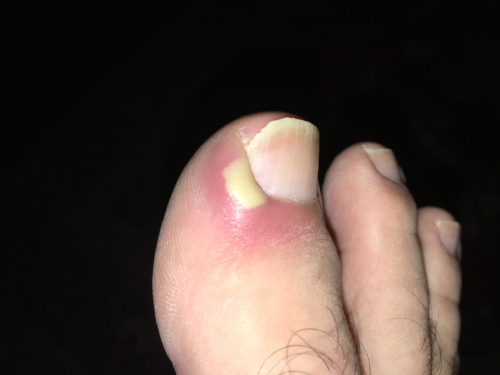- Performed up to 1000 nail surgery procedures during Military career ( ‘87-‘92)
- Performed hundreds more procedures between 1993 - present
- Extensive experience in nail surgery
- Procedures are not rushed.
- Places a patient’s comfort first: ●Conservative treatment attempted when possible, and always as a first resort ●Nail surgery takes place in consult room in a relaxed atmosphere.
Treatment options for ingrown toenails:
- ● Conservative management (non-surgical)
- ● Nail wedge resection (under local anaesthesia) Andrew Jardine has extensive experience in nail surgery and performed over 1500 nail surgical procedures during his military career alone, between February 1987 - to October 1992. During his military service in the South African Defence Force, he was stationed at No: 1 Military Hospital and ran the Podiatry Dept within Orthopaedics Out Patient Department. All nail surgical procedures at 1 Mil Hospital took place in the day theatre under local anaesthesia. In addition, and since 1992, Andrew continues to regularly perform nail surgery as a more permanent solution for problematic, painful ingrown toenails.
Treatment options for painful ingrown toenails include:
Conservative management - this consists of cutting down the side of the toenail (sulcus) in order to remove a painful nail spike. This is performed during the consultation as a standard consultation. This form of treatment may sometimes resolve the problem, but there are also times when the toenail just grows in again. Should this occur, a more permanent solution will be offered…
Nail surgery: A nail wedge resection is performed under local anaesthesia (L.A), as a more permanent solution for a recurring painful, ingrown toenail. (Nail wedge resection with phenolisation of matrix). The procedure is performed in the consultation room in a relaxed atmosphere, and is unrushed. Local anaesthetic is administered very slowly in order to minimize discomfort. It is recommended that pain medication is taken directly after the procedure, whilst the toe is still numb, once again to minimize discomfort. Procedures are usually scheduled for times when there is no one else waiting outside for a consultation, hence procedures are not rushed. Nail surgery includes a follow up review usually 2 days after procedure. Two more reviews are scheduled a week apart. In most cases it may be possible to remove a small slither of nail from the side. The amount of nail removed, however, depends on the severity of the ingrown toenail, the amount of hypergranulation tissue (see definition under causes of ingrown toenails) and curvature of nail sulcus (side of nail). Excessive granulation tissue may need to be excised at the time of the procedure. With nail surgery and phenolisation of matrix there is about 98% chance the offending piece of nail will not return.


Causes of ingrown toenails:
Incorrect cutting of toenails. People often tend to cut right down the sides of their toenails regularly. This habit can lead to toenails digging into the skin, with a resultant painful ingrown toenail. At times a piece of nail, commonly referred to as a nail spike, can easily be left behind as “the bathroom surgeon” has difficulty in seeing/reaching and /or is using make-do nail cutters and other objects. The nail spike grows forward and pierces the skin at the side of the toenail. This often becomes very tender, red, inflamed and pus may be present, indicating infection. Pus pockets then cause an increase in pain, and if left untreated some tissue may form at the side of the toenail. This granulation tissue is the body’s response to a “foreign body” and may later increase in size and become hypergranulation tissue. Hypergranulation tissue develops it’s own vascular and nerve supply and becomes even more tender and bleeds easily/constantly.
Repeated minor trauma to toenail - for example constant pressure from ill-fitting footwear/shoes too small.
Single major trauma to toenail. This could happen in the form of stubbing your toe, dropping a heavy object on your toe or from someone standing on your toe.
Pressure on toenail from adjacent overlapping/overcrowded toes.



